How to keep your lungs healthy
Breathing techniques can be helpful for everything from controlling chronic pain to stopping a panic attack. But breathing techniques can do more than help fix specific problems. They can be good for your lungs in general, and that’s not all you can do for your lungs. Here are some exercises that help you breathe better and keep your respiratory tract healthy, according to experts.

Practice deep breathing
You breathe in and out 12 to 15 times every minute while resting, so take advantage of these breaths by performing some deep breathing lung exercises throughout the day. Simply relax your face, inhale through your nose as deeply as you can, and exhale out through your mouth. “If you want a nice pair of lungs, you want to develop a tidal volume, a fancy word for the total amount of air that you can actually breathe,” says Pamela Peeke, MD, author of FIT To LIVE and spokesperson for the American College of Sports Medicine. Deep breathing opens your chest cavity and allows your lungs to distribute oxygen evenly throughout the body and remove carbon dioxide waste, a gas that can be detrimental to your organs if it’s not removed properly. Take a few more deep breaths after you get out of bed in the morning or before you go to sleep at night to relax your mind and de-stress your body.
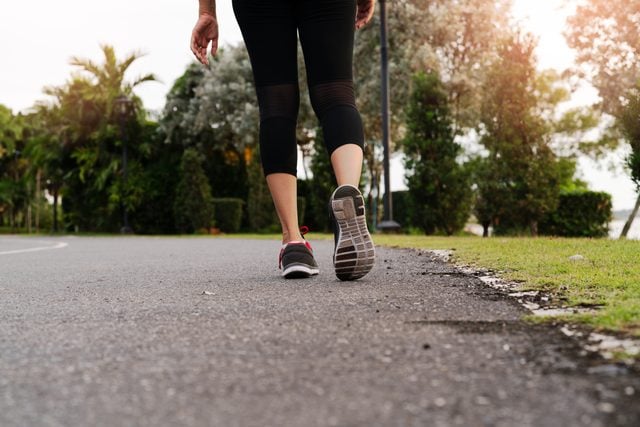
Take a 20-minute walk
A simple exercise that gets your heart pumping and builds up your leg muscles is walking. But doctors often suggest regular walks for patients undergoing pulmonary rehabilitation, which are programs for people who suffer from lung disease. “If you build up all the tissues to function optimally around the diseased organ, it takes the pressure off that uncomfortable organ,” says Richard Casaburi, PhD, professor and chief of the Division of Respiratory and Critical Care Physiology and Medicine, Harbor at the University of California at Los Angeles Medical Center. In this case, strengthening the tissue around your lungs will help them function better. To get the most out of your stroll, stand straight with your head up, shoulders back, and maintain a heel-to-toe stride. These tiny tweaks prevent your rib cage from compressing, allowing your lungs to fully expand. Intensify your cardio by picking up the pace or climbing up a hill; and you can even incorporate deep breathing to increase your air intake and really get your blood pumping. (This is the number of minutes you can walk to feel happier.)
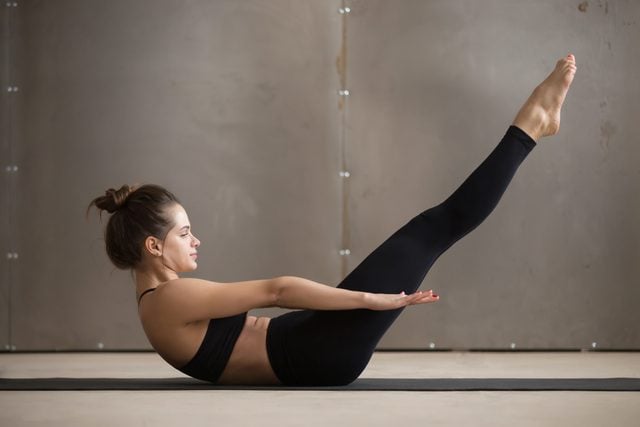
Pick up Pilates
Here’s a Pilates power move that strengthens your diaphragm and controls your breathing, with a side of toned abs and reduced back pain: Lie on your back with your knees bent and feet flat on the floor. Make sure to keep your arms by your sides with the palms facing down. Slowly lift your head, neck, and shoulders off the ground while inhaling as deeply as possible. While you’re half sitting, lift your knees and extend your legs straight out until they reach a 45-degree angle to the floor. Begin pumping your arms up and down 10 times while you take 10 short breaths. Do 10 sets of these until you reach 100.
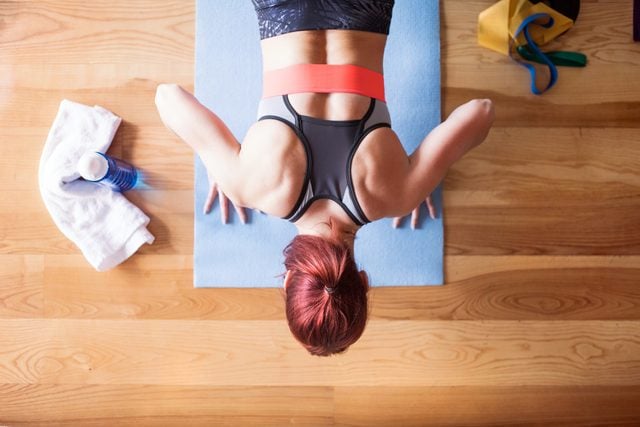
Do baby push-ups
This move looks like a push-up, but without the sore shoulders, and it helps to loosen tight muscles and improve your posture, key to maximum lung capacity. Get in the push-up position with your body flat against the floor. Look down so your neck is aligned with your spine. Press your hands into the ground and take a deep breath in as you slowly lift your head, neck, and shoulders. Keep your arms slightly bent at the elbow as you lift yourself up about 60 degrees from the floor. Lower yourself back down again while slowly exhaling. Repeat this move for 10 reps. “Each time you inhale, this opens up the chest and deepens your lung capacity to correct shallow breathing,” Peeke says.
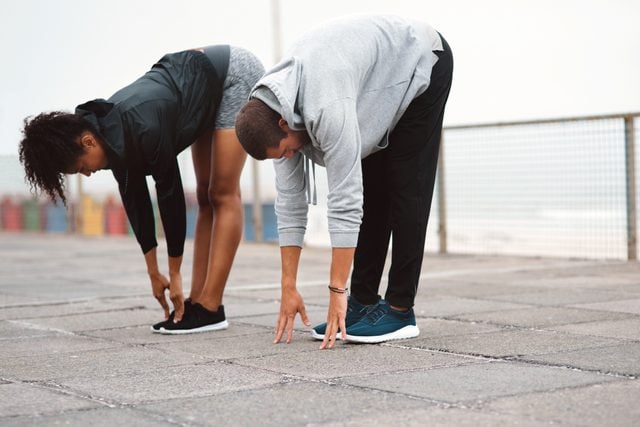
Empty your lungs
Emptying your lungs can ensure they fill fully back up. To do this, stand up straight with your knees loose; bend over at the waist, blowing out all the air from your lungs as you exhale during these lung exercises. Inhale as deeply as possible as you slowly return to an upright position (this fills your lungs to their max capacity). Hold that breath for 20 seconds and extend both arms above your head. Exhale and relax your arms, letting them drop back to your sides. Do this move four times. “Full inspiration and expiration are going to engage the lungs,” Carol Garber, PhD, spokesperson for the American College of Medicine, says. “If you’re sedentary, you’re only using a very small proportion of your lung capacity, so you’re only bringing air into a small portion of your lungs.” This optimal engagement of the lungs delivers oxygen more efficiently throughout your body.

Breathe from your belly
Strengthening your abdomen can improve your breathing. That’s because your diaphragm, located right above your abdomen, is the key muscle your body engages when breathing in and out. Lie on your back and extend your legs flat against the floor with one hand on your stomach and the other on your chest. Inhale deeply, slowly pulling from your abdomen. You know you’re doing it right when the hand on your belly rises higher than the hand on your chest as you breathe. Exhale deeply through your mouth, and try holding your breath at the end for seven seconds.

Practice good posture
Do you feel lethargic in the middle of the day? Run a quick posture check. Bad posture squeezes your lungs and creates a shallow breathing space that depletes your body of the oxygen it needs to feel energized, according to some research published in Multidisciplinary Respiratory Medicine. Stand up straight, it’s easier for your lungs to fill with air and revive your body. “It’s important to keep that lung capacity at an optimal level, [which doesn’t happen] when you’re bent over like a 90-year-old,” Dr. Peeke says. Do a self-check at your work desk by doing these lung exercises: look straight ahead, keeping your shoulders back, placing your feet flat on the floor, and slightly extending your legs out from underneath your chair, so your knees are lower than your hips. Another added bonus: It saves you from a bad case of text neck. (Here’s how improving posture can help back pain.)
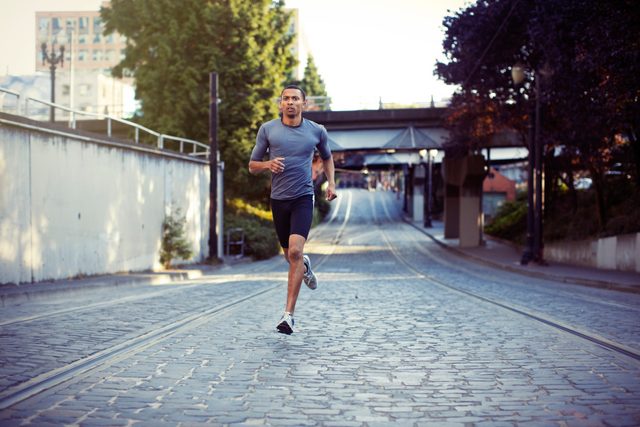
Go on a run
Short bursts of cardio are good for your waistline but endurance sports like running or soccer are better for your lungs. People wrongly place the blame on their lungs for being short of breath, but it’s actually your muscles. “Improving the muscles in your arms and legs improves the efficiency of the lungs,” Garber says. When you overexert your muscles during exercise, they produce lactic acid because there’s not enough oxygen in your body to break down glucose for energy. This lactic acid sets off alarm bells to your body that you need air, which can cause that rapid out of breath feeling. As you gradually build up your endurance for a new exercise routine, your muscles will produce a higher tolerance for this lactic acid and thus save your lungs from working as hard.

Take a dip in the pool
A few strokes across the pool are perfect lung exercises; breathing in through your nose and out through your mouth helps your body properly dispose that carbon dioxide waste and avoid fatigue. Even better, it’ll aid your lungs and your heart. “Whatever you do that helps the lungs helps the heart. It’s a royal win-win,” Dr. Peeke says.
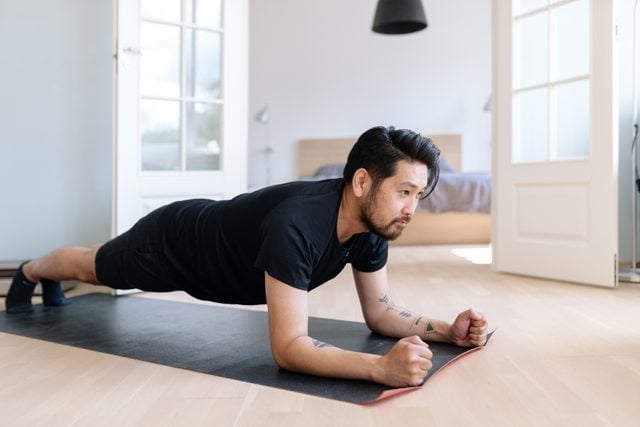
Perfect your plank
Planks will engage both your core and correct your posture (two key ingredients for healthy breathing), as long as your form is right. Here’s how to do a plank: lie flat on the floor like you’re about to do a pushup. Bend your elbows at a 90-degree angle and lift your core up so your trunk is horizontal and parallel to the floor. Rest your weight on your forearms, tighten your abs, make sure your back is flat (not arched or sunk in), and keep your head up; hold for 30 seconds. For the optimal position, your arms should be laying on the ground like a sphinx: palms down and arms perpendicular to each other. “Aligning your spine helps open up the chest cavity and allow the lungs to function,” says Ryan Halvorson, personal trainer and contributing editor for IDEA Health & Fitness Association.

Row an imaginary boat
This move is just like rowing a boat, except you can do it right in your living room, no water required. These lung exercises helps strengthen the upper back muscles and opens your chest cavity, allowing for full lung volume. All you need is a resistance band, which can be bought at most drugstores and sporting goods store. Sit on the floor with your legs straight out in front of you, knees slightly bent. Loop the band around the bottoms of your feet and crisscross it in front of you, so it looks like an “X.” Hold the ends in each hand. Extend your arms out in front of you, then pull backwards until your hands meet your chest. “This helps strengthen the muscles of the back and overcome the internal rotation our shoulders get when we sit for long periods,” says Halvorson. Next, check out these home remedies to battle shortness of breath.